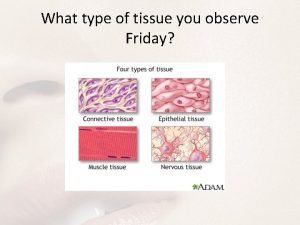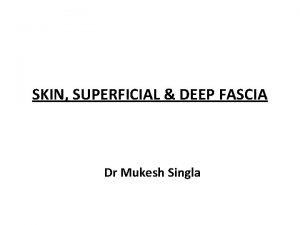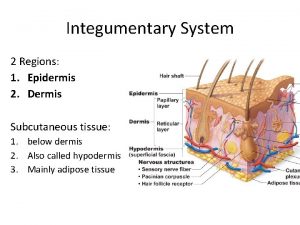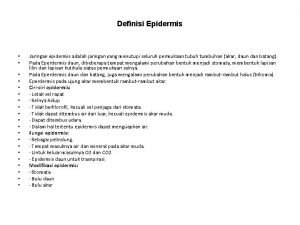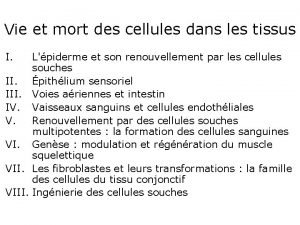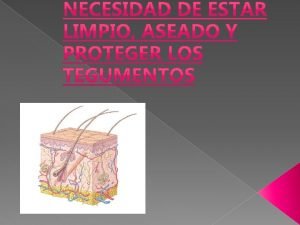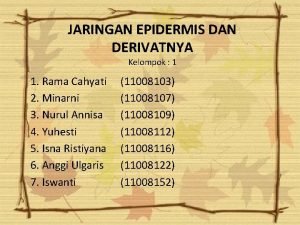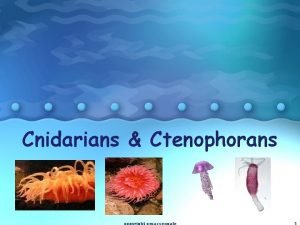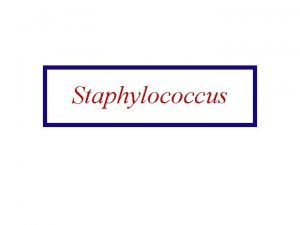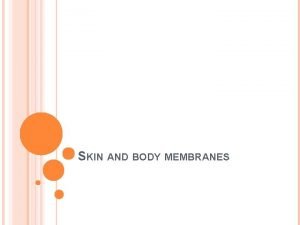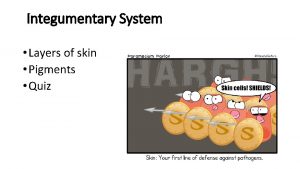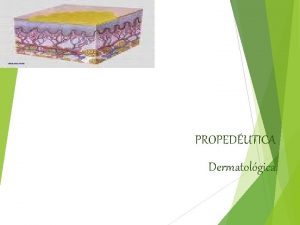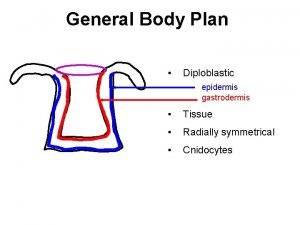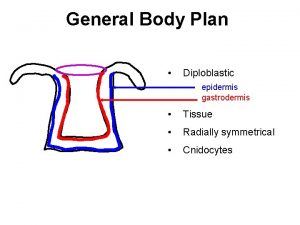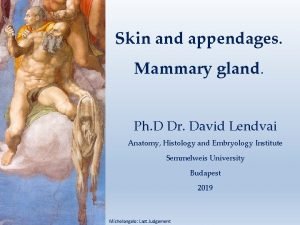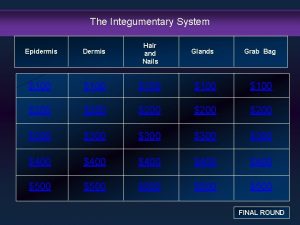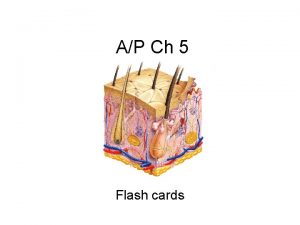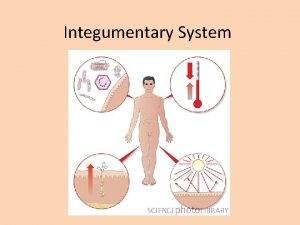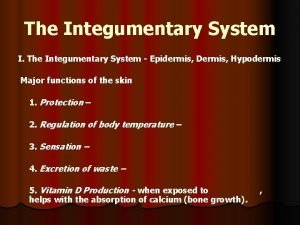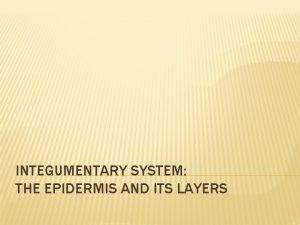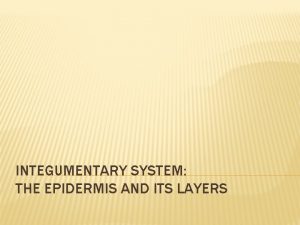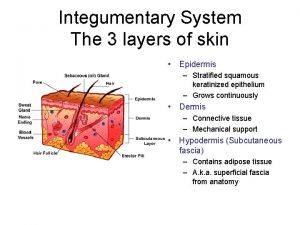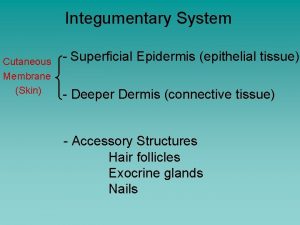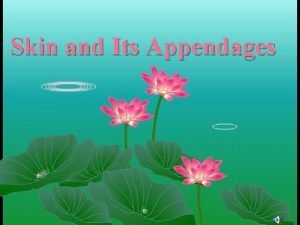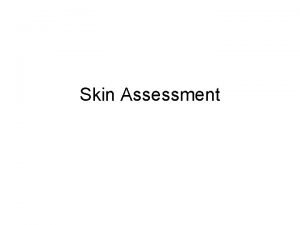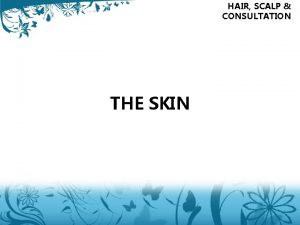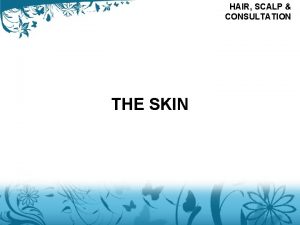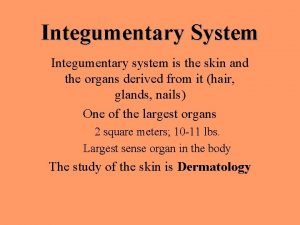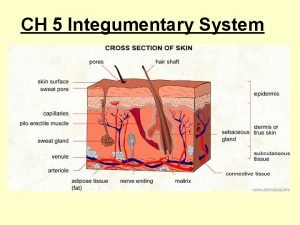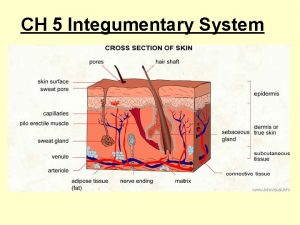Integumentary System Integumentary System n Skin n Epidermis



![Epidermis – Thick vs. Thin Skin n Thick Skin (aka, glabrous [hairless] skin) n Epidermis – Thick vs. Thin Skin n Thick Skin (aka, glabrous [hairless] skin) n](https://slidetodoc.com/presentation_image/4308c21d5a1820babf1cf4e742818aed/image-4.jpg)








































- Slides: 44

Integumentary System

Integumentary System n Skin n Epidermis Dermis Accessory structures (appendages) n n n Glands Hair Nails

Epidermis n n n Outermost layer of the skin Comprised of epithelial cells Contains no blood vessels (avascular) n n n Nutrients diffuse over from dermal blood vessels Is thicker in areas of significant wear and tear (palms of hands and soles of feet) Keratin n n Protein that replaces epidermal cell cytoplasm in order to thicken and protect the skin Also comprises hair and nails
![Epidermis Thick vs Thin Skin n Thick Skin aka glabrous hairless skin n Epidermis – Thick vs. Thin Skin n Thick Skin (aka, glabrous [hairless] skin) n](https://slidetodoc.com/presentation_image/4308c21d5a1820babf1cf4e742818aed/image-4.jpg)
Epidermis – Thick vs. Thin Skin n Thick Skin (aka, glabrous [hairless] skin) n 5 layers n n n Stratum corneum Stratum lucidum Stratum granulosum Stratum spinosum Stratum basale (stratum germinativum) Thin Skin (aka, vellus [hairy] skin) n 4 layers (stratum lucidum is absent and stratum corneum is much thinner)

SC SG SL SS SB Dermis

Epidermis Thick Skin Thin Skin

Epidermal Cells n Keratinocytes n n n Melanocytes n n n Major epidermal cell type ~28 day transit time from stratum basale to stratum corneum Scattered between cells of stratum basale Contain organelles called melanosomes, in which the melanin pigment is synthesized Melanosomes are quickly released and phagocytized by neighboring keratinocytes (epidermal melanocytes do not retain their melanosomes) Langerhans cell – involved in immune response Merkel cell – touch receptor

Epidermal Cells Melanocyte Keratinocytes

Melanin in Stratum Basale Keratinocytes

Dermis n Comprised of elastic connective tissue n n Allows for skin to stretch Contains blood vessels (vascular) and nerves (innervated) Location of accessory structures (sweat glands, oil glands, and hair) Dermal papillae n n Extensions of dermis into epidermal layer Are what form fingerprints

Dermis

Dermal Papillae

Hypodermis aka, subcutaneous layer n NOT part of the skin n Connects skin to surface muscles n Consists of loose connective tissue and fat (adipose) tissue n


Burns n 1 st Degree (aka, superficial partial-thickness) n n n 2 nd Degree (aka, deep partialthickness) n n n Epidermis and possibly a portion of dermis Tissue is reddened and may blister Epidermis and portions of dermis Tissue is blistered and broken 3 rd Degree (aka, full-thickness) n n Full skin and possibly subcutaneous tissue Tissue is broken, dry and pale, or charred Rule of Nines – estimate % of body surface area in treatment of burns

Accessory Structures (appendages) n Glands n n Sebaceous (Oil) Sudoriferous (Sweat) n n Eccrine Apocrine Hair n Nails n

Sebaceous (Oil) Glands n Sebum – oily secretion n n Lubricates skin and coats hair Prevents drying It is believed that bacterial lipases break down triglycerides of sebum into irritative fatty acids that cause acne. Ducts open into hair follicles Meibomian glands n n Modified sebaceous glands Lubricate eyes



Questions to answer (place on separate paper and turn them in on the way out) 1) Why is a third degree burn so much more devastating than a first degree burn? (Answer based on the specific skin layers and structures involved. ) 2) Why does washing your hair actually damage it? How do we treat this damage?

Sebaceous (Oil) Glands

Sudoriferous (Sweat) Glands Cool the body via evaporation n Eccrine Sweat Glands n n Distributed over entire body except lips and parts of external genitalia Ducts open directly onto surface of skin Excrete salts, urea, ammonia, and uric acid along with water



Sudoriferous (Sweat) Glands (cont. ) n Apocrine Sweat Glands n n n Located in armpits (axillae), nipples, and groin area Duct empties into hair follicle superficial to sebaceous gland Become active at puberty Secretion is initially odorless; bacteria on the skin metabolize secretory products to produce malodorous compounds Secrete in response to emotional stimuli (not heat) Modified apocrine sweat glands n n n Ceruminous glands – ear canal; produce cerumen (ear wax) Ciliary glands - eyelids Mammary glands – produce milk (breasts)


Hair n Two types in adults n n n Vellus hairs – thin, short and poorly pigmented Terminal hairs – thicker, longer and more heavily pigmented Composed mainly of “hard keratin” (as opposed to “soft keratin” in the epidermal cells) Arrector pili muscle causes hair to raise, forming goose bumps Hair color is determined by relative amounts of eumelanin (black/brown) & pheomelanin (reddish color)

Hair (cont. ) n n n Shaft – portion of hair above the skin Root – portion of hair below the skin Follicle – sheath of epithelial and connective tissue that surrounds the hair Bulb – located at base of follicle Three phases in life cycle of each hair n n n Anagen – the period of active growth (0. 04 cm per day) Catagen – the period of involution (degeneration) when the lower part of the follicle below the arrector pili muscle atrophies Telogen – the resting period between the end of follicular atrophy and the shedding of the hair

Hair

Nails n n n Comprised of hard keratin from stratum corneum Nail plate – hard portion of nail Nail bed n n Comprised of stratum basale and stratum spinosum Nail plate rests on the nail bed Nail root – proximal part of nail (covered by skin) Nail matrix – contains stem cells that cause nail to grow

Nails

Functions of Skin n n Protect against infection Protect against dehydration n n Regulate body temperature n n Membrane-coating granules (MCG’s) seal spaces between keratinocytes to prevent entry of pathogens and loss of water Vasoconstriction (blood vessels become narrower) – conserve heat Vasodilation (blood vessels open wider) – promotes radiation/dissipation of heat to surrounding air Sweat Sensory reception n Pain Temperature changes Touch (and pressure)

Skin Discoloration Albinism – lack of melanin production due to genetic mutation n Cyanosis – bluish skin color due to decreased O 2 in blood n Jaundice – excessive bile pigments (bilirubin) in the blood causes skin to turn yellow in color n

http: //www. albinism. org/

Cyanosis

Jaundice

(Colloidal Silver Staining)

Skin Disorders n Dermatitis (aka, eczema) n n n Inflammation of the skin Due to irritants such as oil of poison oak or poison ivy, detergents, acids, etc. Atopic Dermatitis n n n Intense itching Skin inflammation Crusting of skin surface

Atopic Dermatitis

Skin Disorders (cont. ) n Psoriasis n n n Faster than normal renewal of cells resulting in accumulation of cells in the stratum corneum Produces red (erythematous), flat areas (plaques) covered with silvery scales Unknown etiology (cause)

Psoriasis

Skin Disorders (cont. ) n Cancer n Basal cell carcinoma – originates in stratum basale n n Squamous cell carcinoma – originates in stratum spinosum n n Caused by UV radiation Caused UV radiation or chemical agents Melanoma – malignant tumor of melanocytes n n n Originates in a mole/birthmark (nevus) Irregular in shape Rapidly dividing cells

Skin Cancer Basal cell carcinoma Malignant melanoma Squamous cell carcinoma

Skin Disorders (cont. ) n Wart (aka, verruca) n n Small tumor Caused by viruses of the human papillomavirus (HPV) family
 Duct of merocrine sweat gland
Duct of merocrine sweat gland Epidermis of thick skin
Epidermis of thick skin Epidermis of thick skin
Epidermis of thick skin Thick vs thin skin
Thick vs thin skin Skin information
Skin information Thin skin vs thick skin
Thin skin vs thick skin Milady chapter 23
Milady chapter 23 What is the function of stems?
What is the function of stems? Superficial fascia
Superficial fascia Hair root plexus
Hair root plexus Dermis epidermis
Dermis epidermis Jaringan epidermis
Jaringan epidermis Mesophyll function
Mesophyll function Epidermis layers
Epidermis layers Epidermal tissue system
Epidermal tissue system Gambar penampang akar
Gambar penampang akar Schistosoma
Schistosoma Epidermis layers
Epidermis layers Hipodermis funcion
Hipodermis funcion Epidermis dan derivatnya
Epidermis dan derivatnya Obelia life cycle
Obelia life cycle Sel parenkim adalah
Sel parenkim adalah Uneven junction of the dermis with the epidermis
Uneven junction of the dermis with the epidermis S. epidermis
S. epidermis Clgsb skin
Clgsb skin Star-shaped macrophages that patrol deep epidermis
Star-shaped macrophages that patrol deep epidermis Periderm
Periderm Peta konsep jaringan hewan dan tumbuhan
Peta konsep jaringan hewan dan tumbuhan Dermatolgica
Dermatolgica Stomata
Stomata Estratos de la epidermis
Estratos de la epidermis Gambar teori histogen
Gambar teori histogen Tipe stomata
Tipe stomata Photomicrograph of thick skin
Photomicrograph of thick skin Ribeiroia
Ribeiroia Epidermis gastrodermis
Epidermis gastrodermis Epidermis
Epidermis Xxcpp
Xxcpp Tissue epidermis
Tissue epidermis Cutaneous membrane
Cutaneous membrane Margo epidermis lateralis
Margo epidermis lateralis These folds shape the epidermis into fingerprints:
These folds shape the epidermis into fingerprints: Phagocytic cells that occupy the epidermis are called
Phagocytic cells that occupy the epidermis are called Integumentary system vocabulary
Integumentary system vocabulary Fetal pig integumentary system
Fetal pig integumentary system

